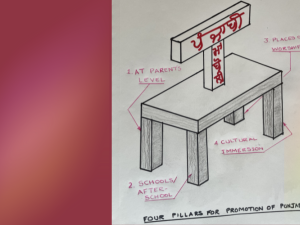This is the Second and concluding part.
Read Part I here
We started the Part 1 with the following quote by Guru Nanak Dev Ji, which are repeated by Guru Ji four times in Japji Sahib as:
ਆਦੇਸੁ ਤਿਸੈ ਆਦੇਸੁ ॥ ਆਦਿ ਅਨੀਲੁ ਅਨਾਦਿ ਅਨਾਹਤਿ ਜੁਗੁ ਜੁਗੁ ਏਕੋ ਵੇਸੁ ॥੨੮॥
“Aadhaes tisai aadhaes. Aadh aneel anaadh anaahath jug jug eaeko vaes.” (SGGS, Pg. No. 6)
Meaning: I bow to Him, I humbly bow. The Primal One, is the Pure Light, without a beginning, without an end. Throughout all the ages, He is One and the Same.
Guru Ji’s simple advice is to offer a salutation to the Primal One, who has no beginning, nor any end. Guru Ji suggesting that, He alone is worthy of our salute. But what is this salutation?
This salutation is a form of devotional worship. So, are there different forms of devotional worship? Guru Arjan Dev Ji provides the answer in these words:
ਭਗਤਿ ਨਵੈ ਪਰਕਾਰਾ ॥
“Bhagat navai parakaaraa.” (SGGS, Pg. No. 71)
Meaning: There are nine forms of devotional worship.
So, let us try to understand what those 9 forms of devotional worship are. They are as under:
When we enter our place of worship called Gurdwara, the first act is of folding of hands together and bowing of head. This is demonstration of surrender and seeking shelter, protection and direction of Guru Ji. This is Bandan or Namaskar Bhagti. Let us see Guru Arjan Dev Ji which form of devotional practice he himself performs. Guru Ji’s answer is:
ਸਗਲ ਉਕਤਿ ਉਪਾਵਾ ॥ ਤਿਆਗੀ ਸਰਨਿ ਪਾਵਾ ॥ ਨਾਨਕੁ ਗੁਰ ਚਰਣਿ ਪਰਾਤਾ ॥੮॥੨॥੨੭॥
“Sagal aukat aupaavaa . Tiaaagee saran paavaa. Naanak gur charann paraataa.8.2.27.” (SGGS, Pg. No. 71)
Meaning: Abandoning all devices and contrivances, I have sought His Sanctuary. Nanak has fallen at the Feet of the Guru.
These words of Guru Arjan Dev Ji in Siree Raag, started with a question about what pleases God. Then, Guru Ji shared the different practices adopted and prevalent in the sub-continent of India. In the end, he shared the method he adopted. The method is surrender and building a loving relationship of a living person with the Total Aliveness- God. Guru Arjan Dev Ji has shared it elsewhere as:
ਸੇਵਾ ਪੂਜ ਕਰਉ ਤਿਸੁ ਮੂਰਤਿ ਕੀ ਨਾਨਕੁ ਤਿਸੁ ਪਗ ਚਾਟੈ ॥੫॥੧੧॥੧੩੨॥
“Sayvaa pooj kara tis moorat kee naanak tis pag chaattai. 5.11.132.” (SGGS, Pg. No. 208)
Meaning: Nanak serves and adores this wondrous person (God), and kisses his feet.
In this one act Guru Ji has incorporated essence of all the nine forms of devotional worship. Guru Ram Das has also commended the approach of Salutation in these words:
ਕਰਿ ਸਾਧੂ ਅੰਜੁਲੀ ਪੁਨੁ ਵਡਾ ਹੇ ॥ ਕਰਿ ਡੰਡਉਤ ਪੁਨੁ ਵਡਾ ਹੇ ॥੧॥ ਰਹਾਉ ॥
“Kar saadhoo a(n)julee pun vaddaa hay. Kar dda(n)ddaut pun vaddaa hay.1.Rahaa.” SGGS, Pg. No. 13)
Meaning: Greet the Holy Saint with your palms pressed together; this is an act of great merit. Bow down before Him; this is a virtuous action indeed. 1. Pause.
Unfortunately, we who claim to be followers of the devotional path of our Guru Jis, go to Gurudwara and fight for the positions to manage those institutions. For us positions of control, authority, status and title have become more important and meaningful than collectively incorporating Guru Ji’s message in our lives. So, for those positions if we have to resort to verbal or physical fights, tossing some one’s turban, we do not hesitate. We go out to the world and ask for recognition of our right to wear turban and fights laws where head covering are not allowed and then make these spectacles for the world, making our own mockery. It is very unfortunate and tragic scene we create for ourselves, and years of effort to fight against discrimination, promote freedom to practice one’s religion are flushed down the drain in minutes. Our Gurus practiced salutation and humility, while we the followers resort to hubris and don’t hesitate to fight for control and power. Let us refresh how Guru Teg Bahadur Ji handled the situation when he was not allowed inside Harimandir Sahib (also known as Golden Temple) to pay obeisance. Guru Ji did not create a scene there he quietly left the place after waiting there for some time. Today that place in the perimeter of that shrine is known as “Thara Sahib” – the Pillar of Patience.
This incident happened very soon after an attempt on Guru Ji’s life and property in Bakala. As soon as Makhan Shah found out about the attack, he marched to Dhir Mall's camp with his soldiers. Dhir Mall and his associates tried to escape, but were nabbed and received a sound thrashing. They were all handcuffed and presented before Guru Ji along with the loot. Guru Ji was so magnanimous that not only he pardoned Dhir Mall, Sheehan, and their other accomplices, but also asked for all the looted property to be returned back to them. Makhan Shah returned everything but decided to keep the Adi Granth, as it was the community property of all Sikhs and not theirs. But Guru Ji scolded Makhan Shah and reminded him that Guru Nanak has given the wealth of Naam and there was no need for anything else besides it. Truly, a magnanimous heart filled with humility, is only capable of holding such an ungrudging gesture. What are we trying to share with the world the story of our Guru’s magnanimous, humble nature which is in state of salutations or our arrogance and tribal nature? It is very sad and painful to see these types incidents repeated again and again. We become the laughing stock of the world, and disgrace to the great legacy of our Gurus. Let us learn from the example of Guru Teg Bahadur Ji and practice those principles of humility and sure enough our hearts will be filled with Salutations in reverence.
Reference:
1. Singh, Bhai Vir. Santhya Sri Guru Granth Sahib. Volume 2 and 3.
2. Singh, Prof. Sahib. Sri Guru Granth Sahib Darpan. Volume 1 and 2.
3. Singh, Sant Ishar. Ishvar Amolak Lal
4. www. Sikhitothemax.com






